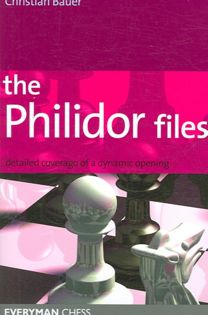Philidor Files, The
Christian Bauer

A decade or so ago I noticed that various Russian grandmasters were using a Pirc move order as a means of transposing into the Hanham Variation of the Philidor Defense. At first I thought this was a bit strange since the Hanham wasnt highly thought of. Why leap from a real opening like the Pirc in favor of the inferior Hanham Philidor? Whats more, I noticed that in many of these Philidor Defenses, Black got quite a good position and often won in impressive fashion. Clearly, this needed to be looked into!
My search for the answer to this mystery quickly bore fruit. It turned out that:
A) The position reached in the classic main line (Hanham) of the Philidor (1.e4 e5 2.Nf3 d6 3.d4 Nf6 4.Nc3 Nbd7 5.Bc4 Be7 6.0-0 0-0) turned out to be far better for Black than I supposed. So striving to reach this position turned out to be a worthwhile pursuit.
B) This line of the Philidor is normally reached by 1.e4 e5 2.Nf3 d6 3.d4 Nf6 4.Nc3 Nbd7 5.Bc4 Be7 etc. However, theorists eventually discovered that 4.dxe5 Nxe4 5.Qd5! simply favors White. In other words, Black cant reach the Hanham Variation!
With this in mind, grandmasters that wished to give the Hanham a ride had to find another road to Rome. This road turned out to be 1.e4 d6 2.d4 Nf6 3.Nc3 Nbd7 4.Nf3 e5 5.Bc4 Be7 6.0-0 0-0.
Does this mean the Philidor devotee is forced to become a Pirc player? If youre a Hanham guy, then yes. However, if you like the very sharp positions that result from the Larsen System (1.e4 e5 2.Nf3 d6 3.d4 exd4 4.Nxd4 g6 5.Nc3 Bg7 6.Be3) and the Antoshin Variation (1.e4 e5 2.Nf3 d6 3.d4 exd4 4.Nxd4 Nf6 5.Nc3 Be7), then you can remain faithful to 1.e5 e5.
Are the Larsen and Antoshin systems playable? LOTS of questions, but where do we find the answers?
The answer to all these questions can be found in one book: THE PHILIDOR FILES by grandmaster Christian Bauer. This Phildor Defense Rosetta Stone not only discusses the whole Pirc vs. Philidor move order situation, but also presents massive amounts of analysis (much of it original), modern games, and insightful conclusions. He leaps into the Larsen and Antoshin systems with tremendous energy, and though Black has certain counterplay, it seems to me that the author doesnt really believe that either line, with best play, offers full equality. At best they rest on shaky ground (though both might prove to be good practical choices).
If the Larsen and Antoshin ultimately prove to be good for White, and if the Hanham offers Black good play, then Black really does have to use the Pirc move order, and Bauer looks at every aspect of this. Some of the questions/situations covered:
1) What if White avoids a transposition into the Hanham by answering 1.e4 d6 2.d4 Nf6 with 3.f3? This is nothing to worry about if you play the Kings Indian (since a transposition after 3…g6 4.c4 Bg7 5.Nc3 0-0 can easily occur), but Bauer also shows that Black has serious alternatives with 3…d5, 3…e5, and 3…Nbd7.
2) How about 1.e4 d6 2.d4 Nf6 3.Bd3? Bauer, over 17 pages, shows that Black gets satisfactory play after 3 …e5 4.c3 d5!
3) Were getting closer to reaching the Hanham. However, what if White throws a spanner in the works after 1.e4 d6 2.d4 Nf6 3.Nc3 Nbd7 with moves like 4.g3, 4.Be3, 4.f4, or 4.g4? Bauer fills 31 pages with analysis of these possibilities, and in the end Black is still alive and kicking in positions ranging from quite positional struggles to insane tactical melees.
4) Were not quite in Hanham heaven yet. After 1.e4 d6 2.d4 Nf6 3.Nc3 Nbd7 4.Nf3 e5 Bauer explores Shirov’s berserker 5.g4!? and finds that Black stands well if he knows what hes doing.
5) Now, with the Hanham just a step away, we are shown that White can still try to avoid it by 1.e4 d6 2.d4 Nf6 3.Nc3 Nbd7 4.Nf3 e5 5.Bc4 Be7 6.Bxf7+/6.dxe5 dxe5 7.Bxf7+/6.Ng5 0-0 7.Bxf7+. Again, Black stands tall through the complications. And this leads us (FINALLY!) to…
6) The Hanham! 1.e4 d6 2.d4 Nf6 3.Nc3 Nbd7 4.Nf3 e5 5.Bc4 Be7 6.0-0 0-0 and now 7.a4, 7.Qe2, and 7.Re1 are all explored in unparalleled depth, with Black holding his own in each case.
THE PHILIDOR FILES is a magnificent piece of work, and offers Black a very interesting, very thorough repertoire choice vs. 1.e4. The analysis is copious, and is too much for players under 1800. However, those from 1800 right up to grandmaster will find this book to be a must own if they dream of playing the Philidor, or if they open with 1.e4 and have to face it.
